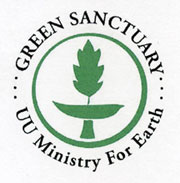A Green Sanctuary
CVUUS was honored to host Rev. Fred Small who designed the Green Sanctuary program adopted by the Unitarian Universalist Association and implemented in over 250 congregations, including CVUUS.
Give Light: Spiritual Support for Climate Engagement
Several joined us in the Sanctuary on Sunday April 6th from 12:30-2:30 PM for a heart-centered workshop with Rev. Fred Small. As we come to understand the gravity of climate disruption, it’s easy to become disheartened. How do we maintain equanimity and compassion for ourselves and others while sustaining engagement? In this interactive program, Rev. Fred Small invited us into meditation, reflection, conversation, and song, fortifying our spirits and deepening our resolve as we face the climate emergency. The purpose of this heart-centered experience was not to examine climate science, policy options, or activist strategies (important as these are) but to reflect upon our emotional and spiritual response to change and challenge. See more about the workshop here.
A Green Sanctuary
Being a Green Sanctuary is one of the ways we work toward a vision of a healthier, more sustainable future. As a recognized Green Sanctuary, we live with a deep awareness of our climate crisis and the deep environmental injustices of our time. We commit to four practices, grounded in Unitarian Universalist principles:
- Environmental Justice: We partner with marginalized communities who are hit first and hardest by environmental crisis. In partnering with these communities we are able to address human and environmental needs at the same time.
- Worship and Celebration: As we work together towards a cleaner, more just and sustainable world, worship inspires our work and reminds us of what is most sacred and most true.
- Religious Education: Our workshops and programs for all ages shape attitudes and build practices that are sustainable and spiritually-grounded.
- Sustainable Living: We treat the world more gently by using fewer resources and being mindful of the choices we make, both as a congregation and as households.
We invite all who share these values to join us on this journey of connection, sustainability, and hope. Contact Lise Anderson to get involved.
Learn about our journey in constructing CVUUS’ green sanctuary finished in 2009 here: houses-of-worship-tour-2016-cvuus
 Citation Award for Excellence in Architecture
Citation Award for Excellence in Architecture
The Vermont Chapter of the American Institute of Architects issued a Citation Award for Excellence in Architecture to gbA Architecture & Planning for sustainable design of our sanctuary meeting house in Dec 2021. Through a highly reflective, participatory, and open process with the entire congregation, it was decided that the experience of the building must be inspiring, but not in a traditional way, and should not focus on traditional religious forms, icons, or dogma. Over a year’s time, it was determined that light would be the guiding principle of the design. Textures, colors, and forms found in and of the space helped to reinforce this aspect. The white walls, white ceiling, white textured acoustic treatment of varied types all aided in creating shadows and reflecting the color of the light and the colors found just outside – the deep greens in the summer, vibrant autumn colors, and the crisp blues of winter are all visible on the surface of the interior.
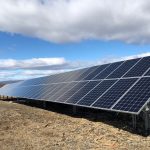 CVUUS Installs Cold Climate Heat Pumps
CVUUS Installs Cold Climate Heat Pumps
In 2024 we installed cold climate heat pumps in the main level of our sanctuary toward our goal of becoming fossil fuel free. We will be installing heat pumps in our newly renovated Fenn Chapel in 2025. We continue to look for ways to electrify everything and to seek renewable energy to offset that electric use.
CVUUS Goes Solar! And helps Parent Child Center go solar, too!
In 2018 we joined with seven area other congregations in the Addison County Interfaith Climate Action Network (ICAN) to support the Addison County Renewable Energy Co-op’s (ACORN) plan to develop a solar energy project in Shoreham. The 17 panels we paid for began offsetting our electric bills when the field came on line, and eventually will pay for themselves. We also pledged an additional 10 percent of our investment for ourselves to a fund to get solar energy for the Addison County Parent Child Center — roughly $960. These congregations and individual donors are also helping the Addison County Parent Child Center join in renewable solar energy sourcing. To celebrate love in action, and to welcome the new light of the winter solstice that will power these new solar panels, we held a special blessing and ceremony of gratitude at the Solar2 construction site in affirming that people of diverse religions and neighbors unaffiliated with any faith community can work together to care for the earth. Location: 869 Watch Point Rd, Shoreham.
More Background: On August 14, 2018 the CVUUS Board voted to invest in Acorn Energy Coop’s AES2 community solar project, whose 612 photovoltaic panels will feed 150 kilowatts peak power into the electric grid. CVUUS was eligible to invest in this project through our membership in the Interfaith Climate Action Network (ICAN). Each investor received credits against their electric bills for energy produced by their share of AES2’s solar panels. Our investment is limited to $10,000, which buys us 17 panels, with peak capacity of nearly 6 kilowatts.
Here’s why investment in AES2 is good for CVUUS:
- It furthers our commitment to the UUA’s seventh principle (respect for the interdependent web of existence). Reducing dependence on environmentally damaging energy sources puts our energy money where our principled mouth is. Although Green Mountain Power has one of the “greenest” energy mixes, it still includes about 24% fossil-fueled electricity.
- It furthers our commitment to the UUA’s second principle (justice, equity, and compassion). We will contribute an additional 10% “mission fee” to help ICAN purchase solar panels for a low-income advocacy organization.
- It makes economic sense: Acorn expects an annual return of 9.36%, paid as electric-bill credits. That translates to about $1000 per year, or some 25% of our annual electricity cost. That 9.36% is a lot more than we earn with money in banks or most other investment vehicles.
AES2 faced a series of regulatory hurdles, which weren’t cleared until July, 2019. Site work began the next month and continued through the fall. The PV panels and associated equipment were installed through the winter, and finally, on March 10, 2020, AES2 went online.
CVUUS recently received our first monthly credit for electricity generated by our solar panels. Our credit was $123—taking some 45% off what would have been a bill of $272. In terms of energy, we consumed 1,360 kilowatt-hours (kWh) for the month, and were credited for 634 kWh of solar generation. That means 47% of our electricity was solar-generated. (That’s a bit more than the 45% of our monetary bill, a result of other charges like our monthly customer charge.)
However, the pandemic means 2020 is an unusual year: We weren’t using our building, and our electricity consumption is down. Last year we used 2,100 kWh in the same period, and estimating from that figure gives suggests that our bill would have been reduced by about 29% if AES2 had been online. But that percentage is probably low, because we consumed more electricity than usual at this time last year while finishing the ground-floor kitchen. So in more typical times we might be getting more than 30% of our electric bill paid through the solar project. That will vary throughout the year, lower in winter and higher in summer, and we’ll need to monitor for a full year to get a good number.
Thanks to our 17 solar panels in the ACORN Energy Solar 2 project in Shoreham, as well as our participation in Green Mountain Power’s new Share Green program, CVUUS’s electric bill for mid-July through mid-August was –$19.25, meaning that we didn’t have to pay anything in August and that $19.25 will be credited against future months’ bills. The ACORN solar project generated 882 kilowatt-hours, 80% of our total electricity consumption.
Do you get your electricity from solar panels? If so, you should have received an email in early July from Green Mountain Power describing their new Share Vermont Green (SVG) program. The idea is that those of us whose solar systems generate more energy than we use can donate excess credits to help Vermont nonprofits and small businesses with their electric bills during these difficult economic times. Your contribution goes to a pool of nonprofits and small businesses who have signed up for the program. CVUUS is one of them, and we’ve already received our first credit. However, you can’t designate CVUUS as your sole recipient; all contributions go to the pool. GMP reports that at present there are more recipients than contributors, so they’re hoping to see more signups from GMP customers who have excess solar credits.
You can sign up with the Sharing Enrollment Form at the SVG program website: https://go.pardot.com/e/150831/vermont-green-/v1g98/292253273?h=QLMO9ulZNoCAzjW7sl2r52iIcdduvyCZbQVxt-4_NlE. After that you’ll get an email with a form to sign, and directions to download a phone app that lets you specify your contribution. (This is given as a maximum daily amount; the actual amount you donate on a given day will depend on your solar production, and may be less but never more than what you specify.)
If you do have excess credits, GMP is going to expire them after they’ve been in your account for a year. So it costs you nothing to give away what they’re going to take back anyway. In our case, we looked back at our electric bills and found that GMP had retired about $60 in credits over the past year. That’s $5 per month, or about 17 cents per day. So 17 cents is what we put for our daily contribution. Rich Wolfson, CVUUS Solar Coordinator
A Solar Year for CVUUS
On March 10, 2020, the Acorn Energy Coop’s Solar 2 facility in Shoreham (AES2) went online. AES2 boasts 612 solar panels and a peak power of 150 kilowatts (kW). CVUUS owns 17 of those panels, and we’re credited with the electricity they generate. We’ve now had a year’s experience with AES2.
It’s been an unusual year, coinciding with the first year of the covid pandemic. With our buildings largely unoccupied, we’ve used considerably less electricity than in a normal year. But the Sun didn’t have to quarantine, so our experience on the solar generation side is probably typical. When we signed on with Acorn Energy in 2018, we had anticipated getting about a quarter of our electricity from solar, but for this unusual year the solar portion has turned out to be 44%. Not surprisingly, solar did best from April to October, supplying the great majority of our electricity in those sunny months.
Energy graph shows solar generation and energy from the grid for CVUUS electric bills received April 2020 through March 2021. The overall height of each column represents our total electrical energy consumption for each month. Total consumption for the year was 15,261 kilowatt-hours (kWh), with 6,763 kWh of that from solar.
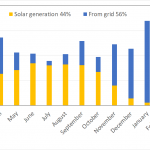
Money is more complicated. We receive several kinds of solar credits associated with our AES2 panels, which totaled $1333. We also get credit from Green Mountain Power’s Share Green program, where owners of individual rooftop solar arrays donate excess credits to a pooled fund for small businesses and nonprofits. CVUUS is a recipient in this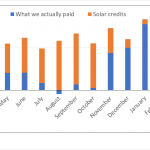 program, and some of us in CVUUS are contributors. CVUUS received $326 from Share Green. On the other hand, we pay a portion of the AES2 maintenance costs; for the current year our maintenance fee is about $350. The net result is that our investment in AES2 covered 41% of our electric bills. That number accounts for the solar maintenance costs, and would have been 52% without maintenance included. The money graph shows details.
program, and some of us in CVUUS are contributors. CVUUS received $326 from Share Green. On the other hand, we pay a portion of the AES2 maintenance costs; for the current year our maintenance fee is about $350. The net result is that our investment in AES2 covered 41% of our electric bills. That number accounts for the solar maintenance costs, and would have been 52% without maintenance included. The money graph shows details.
CVUUS paid $9.369 upfront for our 17 AES2 solar panels. Over a year, they’ve earned us $1,333 in solar credits, or $983 with the maintenance fee subtracted (this doesn’t include Share Green credits, which come from others’ solar panels). That’s a rate of return of 10.5%—greater than we get with money in the bank or most other investments, and greater than Acorn’s estimate of 9.36% when we signed up for AES2. Because the Sun isn’t subject to covid (and is safely distanced at 93 million miles), we can expect this return to continue, approximately, in which case we’ll have paid off our initial investment in less than 10 years (even less counting the Share Green credits). Our building use, however, is subject to covid, and once we’re occupying the building again, then the solar portions of our electrical energy and of our electric bills will likely drop.
Stay tuned for updates! Rich Wolfson
CVUUS promotes Bristol Solar Project to help Clemmons Family Farm
Individual CVUUS members and friends were able to buy into the new Bristol Community Solar Project, a project of the Acorn Energy Co-op. This was a limited-time offer and all units have been subscribed. Another project is planned for Hinesburg. CVUUS participants were able to designate a part of their purchase to benefit the Clemmons Family Farm in Ferrisburgh due to the efforts of the Addison County Interfaith Climate Action Network (ICAN). CVUUS was able to cover the “tithe” to the Clemmons Family Farm and led a dedication at the opening of the new array on Jan 8, 2022.
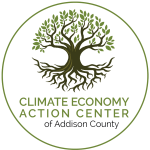 Interested in learning about local climate issues, efforts and successes?
Interested in learning about local climate issues, efforts and successes?
Steve Maier, Richard Hopkins and Jean Terwilliger, who are from this congregation and on the board of the Climate Economy Action Center of Addison County (CEAC, www.CEACAC.org) say,
“We do a monthly e-newsletter that many folks find a good way to learn about local climate issues, efforts and successes (and some broader climate news, too, in brief). You may already get the CEAC newsletter. But if you don’t — and would like to — I hope you’ll take a moment to sign up here: http://eepurl.com/dMlCh2. Thanks!
Gleaning: Our Environmental Justice Project
Gleaning, the collection and redistribution of excess or lightly damaged food, is a CVUUS Green Sanctuary Environmental Justice Project. There are a few ways you can get notices and participate. One way is through the Weekly Blast. Another is by getting notices directly by registering at http://salvationfarms.org/get-involved.html. Select the type of work you’d like to do, which includes planting, gleaning, processing, delivering, admin, etc. You can take home some gleaned items if there’s enough. Anna Freund coordinates gleaning, local food processing and cooking for HOPE, a CVUUS donee. Contact her at 388-3608 ext.225 or email: afreund@hope-vt.org to help with
– In-field harvesting of surplus produce
– Collecting unsold produce at Midd Farmers’ Market
– Delivering produce to HOPE’s food shelf
– Processing produce for winter use (we helped process apples)
Gleaning Guidelines What to bring/ wear or remember before a glean:- Sunscreen and a hat or appropriate rain gear- Water and if needed some snack- Clothes you are ok with getting dirty, layers are also a good idea if we start a glean in the cooler morning then work into a warmer mid-day or vice versa for afternoon gleans into the evening- Closed toed shoes sturdy for farm work. *** For both shoes and clothes please avoid wearing clothes covered in soil, manure, compost from your own farms or gardens***- *Most Important* Use the bathroom before coming to a glean. These facilities are limited and the surrounding woods or fields are not an option.- If you feel sick the day of the glean call the number listed below and avoid coming as we are handling food.-To contact us in the field the day of a glean call 802-377-2016-We will glean rain or shine unless there are thunderstorms or a heat advisory. If there is a cancellation we will contact RSVPs (if you are registered on Salvation Farms)-Please park at the farm and wait for Anna to arrive to receive instructions before we head out into the field.-Always prepare to walk a distance from parking to get to the gleaning location


